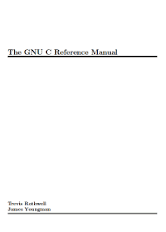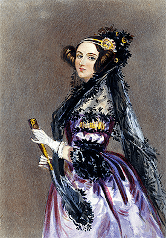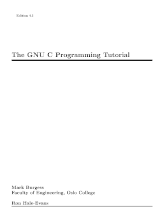Last Updated on September 18, 2025
7. The GNU C Reference Manual by Trevis Rothwell, James Youngman
 The GNU C Reference Manual is a reference for the C programming language and aims to document the 1989 ANSI C standard, the 1999 ISO C standard, and the current state of GNU extensions to standard C.
The GNU C Reference Manual is a reference for the C programming language and aims to document the 1989 ANSI C standard, the 1999 ISO C standard, and the current state of GNU extensions to standard C.
This manual is strictly a reference, not a tutorial. Its aim is to cover every linguistic construct in GNU C, but not the library functions
The book is not designed for new programmers, and is not an introductory text for C.
Chapters cover:
- Lexical Elements – describes the lexical elements that make up C source code after preprocessing. These elements are called tokens. There are five types of tokens: keywords, identifiers, constants, operators, and separators
- Data Types – examines primitive data types, enumerations, unions, structures, arrays, pointers, incomplete types, type qualifiers, storage class specifiers, and renaming types
- Expressions and Operators – also looks at incrementing / decrementing, arithmetic operators, complex conjugation, comparison operators, logical operators, bit shifting, bitwise local operators, pointer operators, the sizeof operator, type casts, and more
- Statements – read about labels, expression statements, the if statement, the switch statement, the while statement, the do statement, the for statement, blocks, the null statement, the goto statement, the break statement, the continue statement, the return statement, and the typedef statement
- Functions – learn about function declarations, function definitions, calling functions, function parameters, variable length parameter lists, calling functions through function pointers, the main function, recursive functions, and more
- Program Structure and Scope – looks at the big picture
- A Sample Program – a complete program written in C, consisting of both a C source file and a header file. This program is an expanded version of the quintessential “hello world” program, and serves as an example of how to format and structure C code for use in programs for FSF Project GNU
The book is available under the terms of the GNU Free Documentation License, Version 1.3 or later.
8. Build Your Own Lisp by Daniel Holden
 Learn the C programming language and at the same time learn how to build your very own programming language, a minimal Lisp, in under 1000 lines of code.
Learn the C programming language and at the same time learn how to build your very own programming language, a minimal Lisp, in under 1000 lines of code.
This book is for anyone wanting to learn C, or who has once wondered how to build their own programming language. It is not designed as a first programming language book, as you need some programming experience to make your way through the content.
Build Your Own Lisp is licensed under Creative Commons Attribution-NonCommercial-ShareAlike 3.0.
A paperback is available to purchase from Amazon.
9. The GNU C Programming Tutorial by Mark Burgess, Ron Hale-Evans
 The GNU C Programming Tutorial introduces the reader to the basic ideas in a logical order. It offers detailed coverage of each of the main elements of the C language and how to program in C, with special emphasis on the GNU/Linux compiler and associated software.
The GNU C Programming Tutorial introduces the reader to the basic ideas in a logical order. It offers detailed coverage of each of the main elements of the C language and how to program in C, with special emphasis on the GNU/Linux compiler and associated software.
There are chapters devoted to functions, variables and declarations, scope, expressions and operators, parameters, pointers, decisions, loops, arrays, strings, input and output, and much more.
The GNU C Programming Tutorial is released under the GNU Free Documentation License, Version 1.1.
Next page: Page 4 – Essential C and more books
Pages in this article:
Page 1 – The C Book and more books
Page 2 – An Introduction to C & GUI Programming and more books
Page 3 – The GNU C Reference Manual and more books
Page 4 – Essential C and more books
Page 5 – Beej’s Guide to Network Programming and more books
All books in this series:
| Free Programming Books | |
|---|---|
| Ada | ALGOL-like programming language, extended from Pascal and other languages |
| Agda | Dependently typed functional language based on intuitionistic Type Theory |
| Arduino | Inexpensive, flexible, open source microcontroller platform |
| Assembly | As close to writing machine code without writing in pure hexadecimal |
| Awk | Versatile language designed for pattern scanning and processing language |
| Bash | Shell and command language; popular both as a shell and a scripting language |
| BASIC | Beginner’s All-purpose Symbolic Instruction Code |
| C | General-purpose, procedural, portable, high-level language |
| C++ | General-purpose, portable, free-form, multi-paradigm language |
| C# | Combines the power and flexibility of C++ with the simplicity of Visual Basic |
| Clojure | Dialect of the Lisp programming language |
| ClojureScript | Compiler for Clojure that targets JavaScript |
| COBOL | Common Business-Oriented Language |
| CoffeeScript | Transcompiles into JavaScript inspired by Ruby, Python and Haskell |
| Coq | Dependently typed language similar to Agda, Idris, F* and others |
| Crystal | General-purpose, concurrent, multi-paradigm, object-oriented language |
| CSS | CSS (Cascading Style Sheets) specifies a web page’s appearance |
| D | General-purpose systems programming language with a C-like syntax |
| Dart | Client-optimized language for fast apps on multiple platforms |
| Dylan | Multi-paradigm language supporting functional and object-oriented coding |
| ECMAScript | Best known as the language embedded in web browsers |
| Eiffel | Object-oriented language designed by Bertrand Meyer |
| Elixir | Relatively new functional language running on the Erlang virtual machine |
| Erlang | General-purpose, concurrent, declarative, functional language |
| F# | Uses functional, imperative, and object-oriented programming methods |
| Factor | Dynamic stack-based programming language |
| Forth | Imperative stack-based programming language |
| Fortran | The first high-level language, using the first compiler |
| Go | Compiled, statically typed programming language |
| Groovy | Powerful, optionally typed and dynamic language |
| Haskell | Standardized, general-purpose, polymorphically, statically typed language |
| HTML | HyperText Markup Language |
| Icon | Wide variety of features for processing and presenting symbolic data |
| J | Array programming language based primarily on APL |
| Java | General-purpose, concurrent, class-based, object-oriented, high-level language |
| JavaScript | Interpreted, prototype-based, scripting language |
| Julia | High-level, high-performance language for technical computing |
| Kotlin | More modern version of Java |
| LabVIEW | Designed to enable domain experts to build power systems quickly |
| LaTeX | Professional document preparation system and document markup language |
| Lisp | Unique features - excellent to study programming constructs |
| Logo | Dialect of Lisp that features interactivity, modularity, extensibility |
| Lua | Designed as an embeddable scripting language |
| Markdown | Plain text formatting syntax designed to be easy-to-read and easy-to-write |
| Objective-C | Object-oriented language that adds Smalltalk-style messaging to C |
| OCaml | The main implementation of the Caml language |
| Pascal | Imperative and procedural language designed in the late 1960s |
| Perl | High-level, general-purpose, interpreted, scripting, dynamic language |
| PHP | PHP has been at the helm of the web for many years |
| PostScript | Interpreted, stack-based and Turing complete language |
| Prolog | A general purpose, declarative, logic programming language |
| PureScript | Small strongly, statically typed language compiling to JavaScript |
| Python | General-purpose, structured, powerful language |
| QML | Hierarchical declarative language for user interface layout - JSON-like syntax |
| R | De facto standard among statisticians and data analysts |
| Racket | General-purpose, object-oriented, multi-paradigm, functional language |
| Raku | Member of the Perl family of programming languages |
| Ruby | General purpose, scripting, structured, flexible, fully object-oriented language |
| Rust | Ideal for systems, embedded, and other performance critical code |
| Scala | Modern, object-functional, multi-paradigm, Java-based language |
| Scheme | A general-purpose, functional language descended from Lisp and Algol |
| Scratch | Visual programming language designed for 8-16 year-old children |
| SQL | Access and manipulate data held in a relational database management system |
| Standard ML | General-purpose functional language characterized as "Lisp with types" |
| Swift | Powerful and intuitive general-purpose programming language |
| Tcl | Dynamic language based on concepts of Lisp, C, and Unix shells |
| TeX | Markup and programming language - create professional quality typeset text |
| TypeScript | Strict syntactical superset of JavaScript adding optional static typing |
| Vala | Object-oriented language, syntactically similar to C# |
| VHDL | Hardware description language used in electronic design automation |
| VimL | Powerful scripting language of the Vim editor |
| XML | Rules for defining semantic tags describing structure ad meaning |
